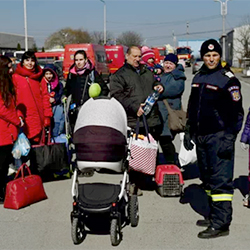By Marie Rosenthal, MS
When Russia invaded Ukraine, more than 3 million refugees fled into neighboring countries, bringing with them a possible resurgence of COVID-19 and other infections.

After weeks of decline, COVID-19 has started inching back up in Europe. In fact, cases around the world increased 8% by March 13, a reminder that COVID-19 is not over, according to Tedros Adhanom Ghebreyesus, MS, PhD, the director-general of the World Health Organization.
No one knows the effect the war in Ukraine will have on the pandemic. Only 34.5% of Ukraine’s population is fully vaccinated against COVID-19.
“I have been fretting about this now for weeks, and I am concerned that the Eastern European countries are under-vaccinated both against influenza and COVID-19,” said William Schaffner, MD, a professor of health policy and preventive medicine in the Department of Health Policy at Vanderbilt University, in Nashville, Tenn.
“I am very concerned that the conditions we are seeing—mass refugees, people crowded together—are ideal for the transmission of respiratory viruses and other infections,” he added.
Testing and surveillance for COVID-19 has decreased worldwide, according to the WHO, which is another issue. As the humanitarian crisis continues, it will be harder and harder to do among the refugees.
“The likelihood that they will be able to do surveillance for COVID is not great,” admitted Stuart Campbell Ray, MD, a professor of medicine at the Johns Hopkins University, in Baltimore, because there are many logistical problems, including whose laboratory would run the tests.
The untenable situation was exacerbated by Russia’s targeting of hospitals and other medical establishments, according to the WHO. As of March 11, the WHO verified 31 reports of attacks on healthcare facilities in Ukraine since Feb. 24. Oxygen and medical supplies are running low.
“I worry about healthcare systems buckling [in Ukraine and receiving countries],” said Rajesh T. Gandhi, MD, a professor of medicine at Harvard Medical School, in Boston.
“Obviously, it’s a complicated situation because the war itself is decimating the ability to provide healthcare, and then if you add to that the potential for increasing rates of severe COVID-19, I think it’s a perfect storm of potential problems.”
Although many countries in Europe are accepting refugees, more than 1.4 million people fled to Poland, a country of about 38 million people, between Feb. 24 and March 9, and the numbers are expected to grow exponentially, according to The United Nations High Commissioner for Refugees.
The situation is complex “with many, many older persons with complex health needs who may not be able to move or cannot move so easily, and getting aid and assistance to them is very important, said Mike Ryan, MPH, MB, BCh BAO, the executive director of the WHO Health Emergencies Programme.
“We have had circulating vaccine-derived polio, COVID and other diseases previously and currently there. There have been previous epidemics of cholera in Ukraine. All of these risks remain,” Dr. Ryan reminded at the briefing.
“Even if the pandemic hadn’t happened, it is well known that whenever you get mass migration, this favors infectious disease transmission,” said Mark Wilcox, MD, FRCPath, who is a consultant and the head of microbiology research and development at Leeds Teaching Hospitals NHS Trust.
“So, if you look at the history of influenza or the history of meningococcal disease, you get peaks whenever you have mass migration. Unfortunately, it’s very predictable, and this is a mass migration where we will almost certainly see a resurgence of COVID-19,” he said.
Look for an expanded version of this story in our Spring print issue of Infectious Disease Special Edition, delivering soon.




